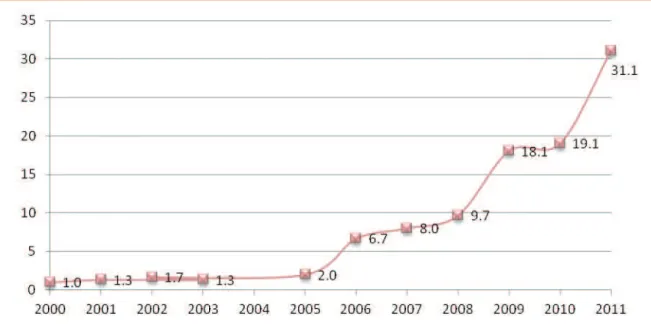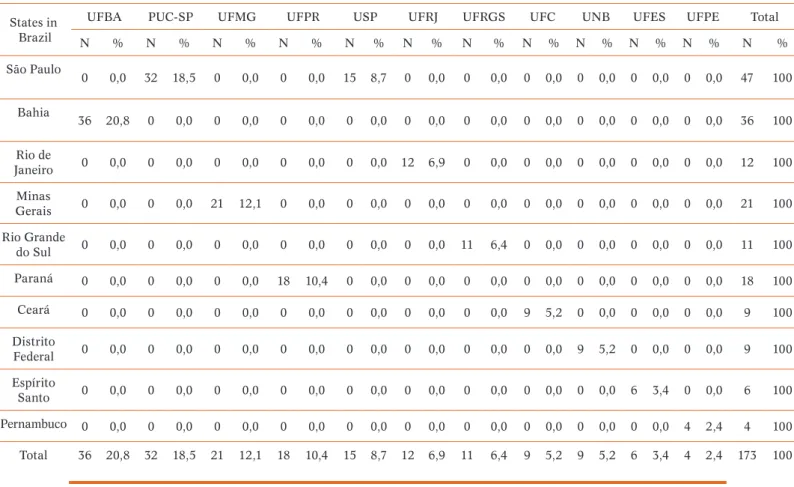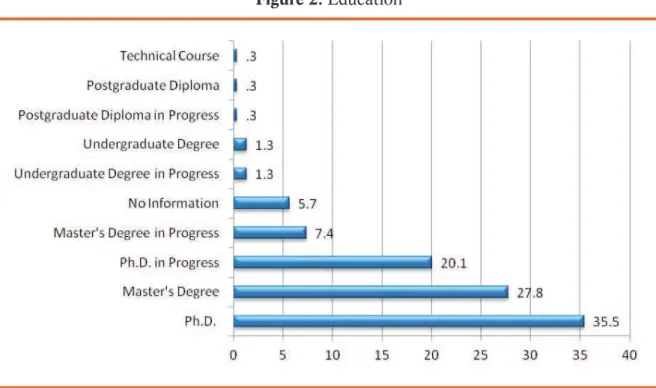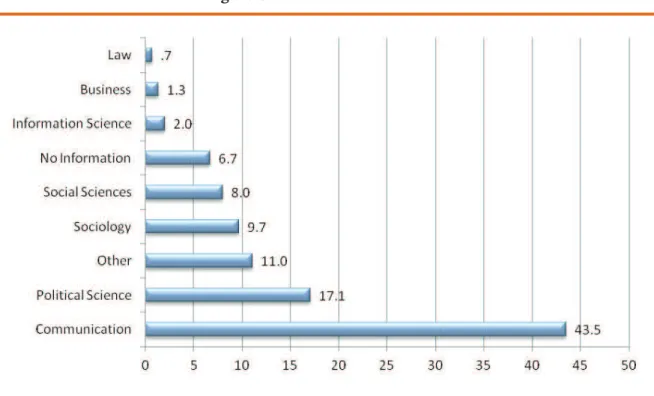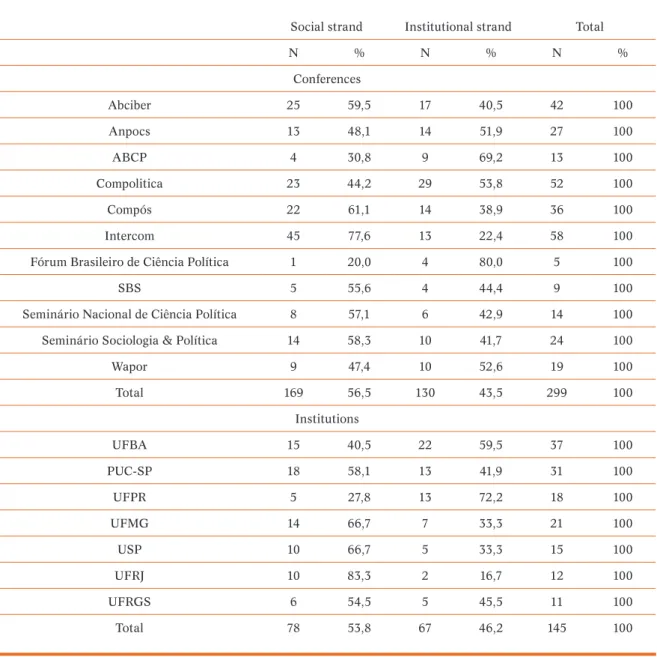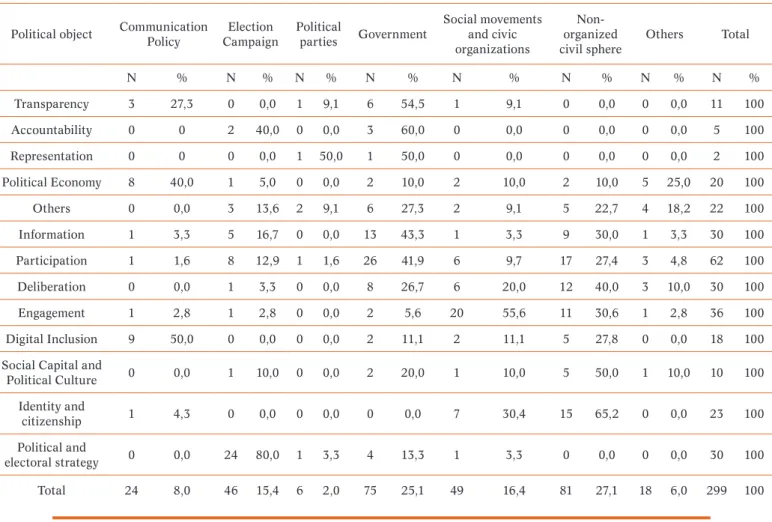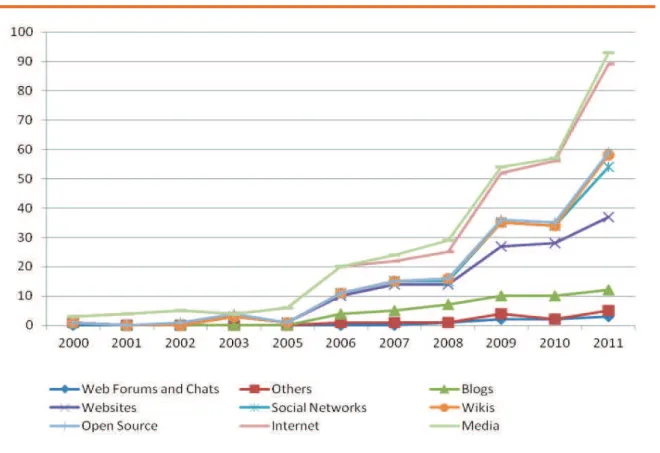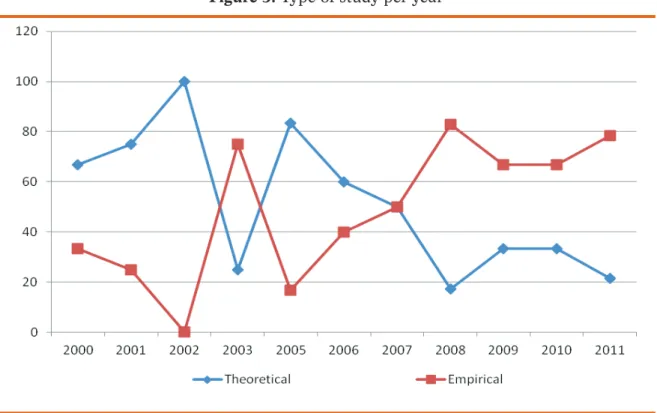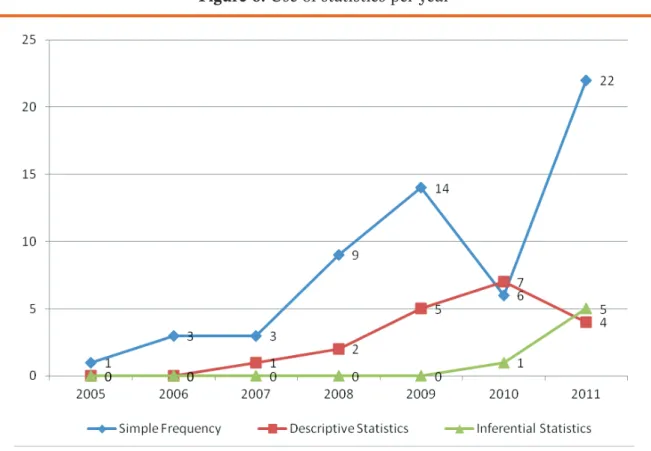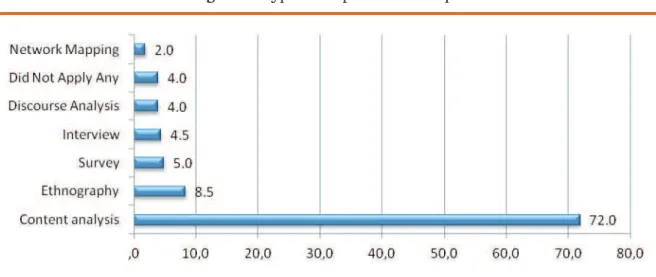A R T I C L E
Internet and Politics Studies in Brazil:
Mapping the Characteristics and
Disparities of the Research Field*
Maria Alejandra Nicolás
Department of Sociology, Federal University of Paraná (UFPR), Brazil
Rachel Callai Bragatto
Department of Sociology, Federal University of Paraná (UFPR), Brazil
Rafael Cardoso Sampaio
Program on Contemporary Communication and Culture, Federal University of
Bahia (UFBA), Brazil
This article focuses on the appropriation of the subject of Internet and Poli-tics by Brazilian Social Sciences. To this end, we analysed 299 papers presented at 11 conferences in the areas of Sociology, Political Science and Social Communica-tion from 2000 to 2011 in Brazil. The methodology was based on content analysis in order to map the main authors, research centres, political and technological objects, theoretical approaches, methods, techniques and coverage areas of the papers presented in each of these conferences. Our findings suggest significant growth in the number of studies presented over the last few years, where 40.5% were based mainly on qualitative research and 56.5% had an emphasis on the civil society strand. Finally, our longitudinal analyses indicate some changes in the field, with a growing number of studies carrying out empirical research, and a ten-dency to focus on more specific digital tools instead of on the Internet in general.
Keywords: Internet and politics, digital democracy, academic research,
po-litical science, Brazil
Introduction
D
espite still being considered a ‘new media’, the Internet is already a lady in her forties: the Arpanet, its predecessor, was created during the Cold War period, between the 1960s and 70s, and the Internet as we know it today started to spread in the beginning of the 1990s, just after the invention of the World Wide Web in 1989. Since this happened, many authors and researchers have investigated, wondered and argued about the impact of this media on many fields, including politics and, more specifically, on the democratic system. Such reflections have tried to assess how the technological aspects of the Internet, such as its interactivity, multimedia characteristics and capacity to store information impact on political systems and civil society organizations.Thus, several studies of political topics have addressed the changes related to the inclusion of Information and Communication Technologies (ICTs) in social dynamics. In-deed, in Western countries, the use of the Internet by the most diverse types of political actors and institutions participating in the political system has been the object of system-atic and empirically oriented analysis, especially in Anglo-Saxon nations (Medaglia, 2012; Sæbø, Rose and Flak, 2008; Susha and Grönlund, 2012). In fact, Chadwick and Howard (2009) have indicated that studies on Internet and Politics have overmatched research on mass media and politics in the English language.2
In Brazil, as in many other countries, there is a broad and continuous amount of publishing in this field. There are studies on the opportunities for participation offered by the State to the civil sphere (Braga, França and Nicolás, 2009; Bragatto 2008; Nicolás 2009); on online campaigns and the impact of the Internet on electoral disputes (Aggio, 2010); debates about the effects of the Internet on party organization (Albuquerque and Martins, 2010); issues related to new political practices (Penteado et al., 2011); reflections on the potential of the Internet as a public sphere and for online deliberation (Sampaio et al., 2011); on the uses of new media by civil society organizations (Maia, 2006); and on the relation between new media and social inequality (Moraes et al., 2009), among others.
Although the Brazilian bibliography is extensive and although there are efforts to try to identify and summarize the study questions, initiatives to map the Brazilian research that seek to gather data on academic publishing are still rare. Other than the efforts made by Amaral and Montardo (2011), Araújo (2011) and Bragatto and Nicolás (2011), we can-not find attempts that would enable a systematic recognition of the state of the art, that is, by major universities or authors, or the approaches, themes and objects that have guided research in the field in Brazil.
The purpose of this paper is therefore to present the results of our research on the appropriation of the Internet and Politics theme as an object of study by Brazilian Social Sciences, especially by Sociology, Political Science and Communication. To this end, we analysed papers presented on the subject at some of the major conferences held in Brazil from 2000 to 2011 (N= 299).
In order to present our research, we have organized this article as follows: (1) first, we carry out a short review of the studies on Internet and Politics, emphasizing the digital democracy approach; (2) second, we present a summary of the methodology employed; (3) third, we examine some empirical evidence of the research; (4) and finally, we close the paper with some considerations and notes about the research agenda.3
Internet and Politics
In the same way as in the advent of the telegraph, radio and television, discussions about the impact of the Internet on political activities have been accompanied by what could be termed the discourse of technological determinism – the rhetoric about radical changes caused by the social and political appropriation of new technological artefacts. Throughout history, there has been the idea that new technologies would promote, invig-orate or cause ruptures in the democratic system (Wright, 2006).
Considering the impact of the Internet on democracy, Vedel (2006) identifies three main “ages”. The first one emerged in the 1950s with cybernetic sciences under Norbert Wiener’s4 supervision. At that time, the idea was to use computer technology and auto-mated systems to re-evaluate the processes of political negotiation and conflict resolution. Thus, computers would function as new mediators, since it became possible to process large amounts of information and to arrive at more “rational” conclusions. Of course, this approach was strongly criticized for its over-simplification of politics “into a practical, scientific system that can respond to the environment in predictable manners and achieve well-defined goals, and termed (…) technocracy” (ibidem, pp. 227).
was highly influenced by social movements which defended that “society would be better transformed from the bottom up and the coordination of local actions rather than through the conquest of the state central apparatus” (idem, p. 228). Thus, local communities were considered the key political arenas for participation experiments. Television was used to broadcast public hearings, debates and citizen discussions, enabling interactivity through telephone callbacks. This phase, usually known as ‘teledemocracy’, faced several techno-logical limitations, such as a lack of real interactivity, and interconnectivity problems with computer networks. Nevertheless, Vedel recognizes that this period of experimentation generated active interest for the democratic potentials offered by ICTs (see also Arterton, 1987).
The third stage started with the emergence of the commercial Internet in the 1990s and was accompanied by a new ideology of freedom of information and of cyberspace itself (Coleman, 2007; Vedel, 2006). Vedel (2006) defends that the first visions were based on the ‘Californian ideology’, which stands for social solidarity, political liberalism (i.e. less power for the State) and ecological concerns. Hence the Internet was not just a tool for de-mocracy, “it creates a new way of being together and a novel polity, which no longer takes place within the bounded territories of nation states, but in an open, de-territorialized, non-hierarchical space” (Vedel, 2006: pp. 229).
In his turn, Coleman (2007) believes that the emergence of the Internet led to an im-petus for grandiose narratives of technocratic determinism. These narratives were based on two main assumptions. Firstly, the Internet was regarded as a new frontier, a deterri-torialized cyber-utopia beyond comprehension or control by the State. Secondly, the feed-back possibilities would allow everyone to vote directly on every issue and it would defy ‘old’ forms of political representation (i.e. direct democracy).
In the subsequent years (from the late 1990s until the early 2000s), several empirical research projects were carried out to test these points of view. Not surprisingly, the ma-jority of the studies found that the introduction of these new technologies did not result in immediate and profound changes in hard politics. Some even called this ‘politics as usual’, since the political system actors adapted the new technologies to their own agenda and needs (Margolis and Resnick, 2000; Wilhelm, 2000).
create or seize such opportunities have become subjects of study (Gomes, 2011; Marques, 2010; Medaglia, 2012; Sæbø et al., 2008).
In this way, we would like to highlight four important issues that have guided our research: theory, design of digital tools, strands and methodology. Firstly, regarding the theory, just as different views of democracy have always been present in discussions on political theory, the same is true about research focusing on the impact of the Internet on the experience of democracy. Liberals emphasize the need for greater visibility and accountability. Supporters of strong democracy call for a conformation of spaces in which citizens can express their will directly. Deliberative democracy theorists emphasize the importance of exchanging rational arguments in public and the public sphere issue (Dahl-berg, 2011; Gomes, 2007). Regarding our study, we have analysed the different theoretical approaches used by researchers and whether or not they bear any relation to the political objects.
Regarding the design of digital tools, one cannot ignore that this is a direct conse-quence of political forces behind its development (Chadwick, 2006; Gomes, 2011; Salter 2004). But, more than that, several factors can hinder or foster online political partici-pation and the adoption of online tools, and design is considered an important variable. Some research projects have already indicated that a poorly designed website can inhibit political discussion (Janssen and Kies, 2005) and participation in e-government (Bezerra and Jorge, 2010) and e-democracy projects (Sampaio, Maia and Marques, 2011). Finally, the different options and features of each digital tool should be considered in this evalu-ation. For instance, one could analyse the need for identification, the role of moderation, technical features of each software (e. g. how reply and feedback work, if it is voice or text-based, if it is possible to send/upload images, videos, files, emoticons and so on, if it is more “online forum-like” or if it resembles a social network website), etc (Janssen and Kies, 2005; Salter, 2004; Wright and Street, 2007). Of course, design should not be regard-ed as the main deciding factor for whether digital initiatives succeregard-ed or not, as this would be a sort of technical determinism (Coleman and Blumler, 2009). Nevertheless, ignoring this question could also lead to an incomplete evaluation (Marques, 2010). Hence, this study will both map the different technological tools (websites, blogs, wikis or social net-works, for example) and the political objects (i.e. government or organized civil society) analysed in Brazilian studies.
Internet can provide suitable places for the formulation of preferences, strengthening of links between groups with the same interests, organization of social demands and ripen-ing of political and ideological positions.
The “institutional view” addresses three things:
a) the study on the digital conformation of democratic institutions in a strict sense (digital cities and governments, online parliaments) or in a broad sense (on-line political parties); b) the institutional initiatives in the vector that goes from State to citizens (such as the provision of online public services and e-govern-ment); and c) institutional initiatives in the citizen to State vector (opportunities for participation or offer of input by the citizenry in the form of votes, responses to surveys, budget decisions or suggestions, records and discussion of opinions in electronic forums, etc.) (Gomes, 2007: pp. 11).
The considerations here are of a more structural order, since they relate to the orga-nization of democratic dynamics and, consequently, the link between institutions of the democratic State and the citizenry.5 These two strands will be verified in the Brazilian research papers.
Finally, one should consider the methodological approach of the different research projects themselves. According to Macintosh and Whyte (2008), incomplete or incorrect methods account for some low results from the e-participation fields. Aström and Grön-lund (2012) show strong evidence for this hypothesis with their analysis on the results of several research projects in the field. They found that the better the evaluation, the better the results; in other words, badly designed research could lead to false/incomplete results.6 Although there is some degree of determinism in this statement, since it denies the reality of the study object and establishes that low research results are due to a bad investigation method (and what is a desirable method is largely a normative definition), it also indicates the need for different methods for distinct purposes. In relation to the present study, this means that a large variety of objects should, in some way, be followed by an equivalent quantity of methods and techniques. That could be considered an indicator of an episte-mologically mature field.
Given the above theoretical assumptions, which are not exhausted by the authors or the ideas mentioned, in the next section we will move on to a presentation of the method-ology for analysing the papers presented at conferences in Brazil, considering these four points as starting points. Three main research questions guided the construction of our methodology and database:
• Research Question 2: Was such a tendency followed by an equal distribution of research among the different regions of Brazil? Or could one identify a concen-tration of leading institutions and objects of research?
• Research Question 3: Finally, what are the main elements of the Internet and Politics field regarding its theoretical approach, research object and methodology?
Methodology
Our methodology was structured so as to construct variables allowing a compar-ative analysis of papers about Internet and Politics mapped in the selected conferences. Similar research has already been conducted, especially abroad. We highlight the work of Kræmmergaard and Schlichter (2011), which lists 450 articles on e-government from 2000 to 2009, of Sæbø et al. (2008), who found 131 articles on e-participation published until 2006, and of Medaglia (2012), who, in continuity with the research by Sæbø and team an-alysed 123 articles on e-participation in the period from 2006 to 2011. In turn, Susha and Grönlund (2012) worked only with articles presenting e-participation frameworks (N=50) and Aström and Grönlund (2012) dealt only with research covering specific e-participa-tion projects (N=58). Nevertheless, there are still few research projects covering countries other than Europe and the United States, especially comparative ones (Chadwick and Howard, 2009).
In Brazil, as mentioned before, there is still a gap in such comparative studies (Roth-berg, 2008). There are few studies focused on mapping research related to Internet and Politics. We found only three. First, Amaral and Montardo (2011) made an analysis of all the papers presented in the Cyberculture sessions at the Intercom Meeting from 2001 to 2010 (N=443) and identified 13 major themes in the studies. Secondly, Araújo (2011) listed the Brazilian works in the area of cyberactivism from 2000 to 2010 (N=22) and classified them according to the publication period, the authors’ area and institution, the research object and bibliographical sources. Finally, Bragatto and Nicolas (2011) mapped studies presented at four Brazilian conferences between 2006 and 2010 (N=71), which were categorized according to themes, objects of study, types of approach, methods and research techniques.
Initially, it was necessary to separate political activity from acts of sociability to avoid grouping very disparate researches. Therefore, we considered two key questions. The first was the object of study and the second, the objective made explicit by the authors. The pa-pers were only included in the sample if their object and/or objective were directly related to political actors or political activities.
Regarding our sample, we considered the main Sociology, Political Science and Com-munication conferences held on Brazilian territory. The period covered goes from 2000 to 2011. Besides believing that a decade of analysis leads us to more general conclusions and to a better monitoring of the field’s trajectory, it is also the case that the first annals of Brazilian conferences became available online in 2000.
We analysed 299 papers presented at 11 conferences. We checked all annals and pro-ceedings available online. In order to apply the questionnaire, we used three progressive rules as follows: 1) initially, we checked only the title and the abstract, 2) if this was not sufficient, we also evaluated the introduction and conclusion and, if any doubts remained, 3) various parts of each paper were examined.
For the testing and subsequent refinement of the criteria, three pilot studies were conducted. In the first one, 30 papers were analysed and the problems and difficulties re-ported, which led to changes and improvements in the indicators. In the second pilot test, the application was remade with the 30 original papers and another 30 were added, but using the new categories created after the first pilot. Finally, the third test involved the ap-plication of the criteria to another 30 papers different from the previous 60. Small changes were made to the spreadsheet, which then reached its final form, as described below.
a) Conferences: we considered the seminars, conferences, meetings and symposia held in Brazil. We adopted certain criteria in this selection: the existence of a work group, area or session that included studies on the relationship between the Inter-net and Communication, Sociology or Political Science; regular periodicity; na-tionwide coverage; possibility of participation by graduate students. Each paper was classified as to (1) the name of the conference, (2) the institution hosting the conference, (3) the year of the conference, (4) the name of the session.
b) General characteristics of the paper: we collected information related to the name of the paper, the keywords and, lastly, the level of detail required for analysing the paper: (1) abstract, (2) abstract, introduction and conclusion (3) various parts of the paper.
(i.e. Master, PhD, Post-doctorate); (5) area of expertise7 (we considered the area of the author’s last qualification); (6) whether the author is a professor; (7) if so, at which institution; (8) whether the author belongs to a research group; (9) the number of authors, and (10) in cases where there was more than one author, if it was an inter-institutional partnership, which could indicate a greater consolidation of the field.
d) Type of strand: corresponds to the distinction observed in the papers, if social or institutional. For the categorization, we used Gomes’s classification (2007), as cited.
e) Theoretical approach: at this point, the goal was to verify the texts’ main theoret-ical approach. However, there are a multitude of theorettheoret-ical areas in Internet and Politics, so we chose to create broader categories8 that would summarize the main theoretical approaches in the area: (1) Transparency, (2) Information, (3) Partic-ipation, (4) Deliberation, (5) Engagement, (6) Digital inclusion, (7) Social capital and political culture, (8) Identity and citizenship, (9) Political and electoral strate-gy, (10) Accountability, (11) Representation, (12) Political economy, (13) Other. f) Technological object: that is, the media or digital tool analysed by the paper
be-ing evaluated. We considered the followbe-ing categories: (1) Discussion forums and chats, (2) Blogs, (3) Websites, (4) Social networks (Orkut, Facebook, Twitter etc.), (5) Wikis (Wikileaks, Wikipedia etc.), (6) Open source software, (7) Content share sites (YouTube, Flickr), (8) Internet, (9) Media, (10) Other. The categories “Internet” and “Media” were created after the first pilots of the analysis because some papers (especially the theoretical ones) did not address specific technological objects.
g) Political object: we chose categories that would systematize the main points of attention of the studies on Internet and Politics: (1) Communication policies, (2) Electoral campaigns, (3) Political parties, (4) Government (Executive, Legislative and Judiciary), (5) Social movements and civic organizations, (6) Non-organized civil sphere (“spontaneous” political movements9), (7) Other.
h) Methodological variables: in this item we included the variables related to the methodology issues of the papers. It consists of the following:
1. type of approach: (a) Theoretical, (b) Empirical;
2. type of method: (a) Qualitative, (b) Quantitative, (c) Bibliographical – the classification results from the type of technique used in the research;
(3) Interview, (4) Discourse Analysis, (5) Content Analysis, (6) Mapping of networks, (7) Did not apply any of the aforementioned techniques.
4. use of statistical technique: firstly, we applied a dummy variable on the use of statistics (or lack thereof), and then verified the type of statistics used. They were: (1) simple frequency, (2) descriptive statistics, (3) inferential statistics.
Results
Regarding the evolution in the number of papers submitted each year, we can see in Figure 1 that up until 2005 the percentage of papers presented did not exceed 2% of the total sample. There is a notable curve in 2006 (6.7%), with a tendency for papers pre-sented over the years to increase. And finally, we can observe that in 2011 there was a considerable percentage of papers (31.1% of the sample) and that out of the 11 conferences analysed, papers were collected in nine of them, indicating a significant and more homo-geneous growth in publishing.
Figure 1. Papers per year
Source: Authors.
Institutions and Authors
With regard to the authors, we analysed variables related to the institutions to which they belonged, the region and state, education and area of their last degree, as well as whether they wrote in co-authorship and if they belonged to any research groups.
Table 1. States in Brazil and Education
Leading institutions
States in Brazil
UFBA PUC-SP UFMG UFPR USP UFRJ UFRGS UFC UNB UFES UFPE Total
N % N % N % N % N % N % N % N % N % N % N % N %
São Paulo
0 0,0 32 18,5 0 0,0 0 0,0 15 8,7 0 0,0 0 0,0 0 0,0 0 0,0 0 0,0 0 0,0 47 100
Bahia
36 20,8 0 0,0 0 0,0 0 0,0 0 0,0 0 0,0 0 0,0 0 0,0 0 0,0 0 0,0 0 0,0 36 100
Rio de
Janeiro 0 0,0 0 0,0 0 0,0 0 0,0 0 0,0 12 6,9 0 0,0 0 0,0 0 0,0 0 0,0 0 0,0 12 100
Minas
Gerais 0 0,0 0 0,0 21 12,1 0 0,0 0 0,0 0 0,0 0 0,0 0 0,0 0 0,0 0 0,0 0 0,0 21 100
Rio Grande
do Sul 0 0,0 0 0,0 0 0,0 0 0,0 0 0,0 0 0,0 11 6,4 0 0,0 0 0,0 0 0,0 0 0,0 11 100
Paraná 0 0,0 0 0,0 0 0,0 18 10,4 0 0,0 0 0,0 0 0,0 0 0,0 0 0,0 0 0,0 0 0,0 18 100
Ceará 0 0,0 0 0,0 0 0,0 0 0,0 0 0,0 0 0,0 0 0,0 9 5,2 0 0,0 0 0,0 0 0,0 9 100
Distrito
Federal 0 0,0 0 0,0 0 0,0 0 0,0 0 0,0 0 0,0 0 0,0 0 0,0 9 5,2 0 0,0 0 0,0 9 100
Espírito
Santo 0 0,0 0 0,0 0 0,0 0 0,0 0 0,0 0 0,0 0 0,0 0 0,0 0 0,0 6 3,4 0 0,0 6 100
Pernambuco 0 0,0 0 0,0 0 0,0 0 0,0 0 0,0 0 0,0 0 0,0 0 0,0 0 0,0 0 0,0 4 2,4 4 100
Total 36 20,8 32 18,5 21 12,1 18 10,4 15 8,7 12 6,9 11 6,4 9 5,2 9 5,2 6 3,4 4 2,4 173 100
Source: Authors.
Table 1 also shows the analysis by institution, from which it is possible to evaluate publishing profiles by states in Brazil. Indeed, the Southeast is the predominant region,13 with a significant concentration of publications (49.6%). This is not due to the work of only one university – four universities contributed to this. The Southern region14 came sec-ond (16.8%), but well below the Southeast. As far as Bahia’s prominent place is concerned, it is possible to establish a close relationship between its placement and publications by UFBA. It is also worth mentioning that among the seven leading institutions, six of them are public universities and five are federal institutions.
We identified 282 distinct authors in the 299 papers of our sample. Regarding the authorship of the papers, a considerable amount was written by only one author (66.2%), representing more than half of the sample. Although a large part was written in co-au-thorship (33.8%), a very modest amount made a partnership between institutions (8%). Of the papers with only one author, more than half were written by authors who belong to a research group (57.5%). However, several authors did not specify whether they participat-ed or not in groups.
With regard to the title of the author, in Figure 2 one can see a concentration of au-thors with a high level of education: Ph.Ds (35.5%), followed by Master’s students (27.8%) and doctoral students (20.1%).15
Figure 2. Education
Source: Authors.
If we add Sociology (9.7%) and Social Science (8%) to these areas, there is a concentration of almost 80% of the sample. These data show that a significant proportion of researchers participate in conferences pertaining to their areas of academic education and that the conferences analysed tend not to be so interdisciplinary.
Figure 3. Area of the Researcher
Source: Authors.
We found that the first 20 authors presented an average of four papers in the period analysed, representing 28% of the sample. It is a significant concentration if we consider that the total average of the rest of the researchers is one paper.
Strands, Approaches, and Objects
Table 2 shows the relationship between the strands and the leading academic insti-tutions. Most notable are UFBA and UFPR, with the majority of papers belonging to the institutional strand. On the other hand, UFMG, UFRJ and USP showed research that was significantly more focused on the social strand. This is possibly explained by research ar-eas and groups related more to one strand than the other.
Table 2. Conferences, academic institutions and types of strand
Social strand Institutional strand Total
N % N % N %
Conferences
Abciber 25 59,5 17 40,5 42 100
Anpocs 13 48,1 14 51,9 27 100
ABCP 4 30,8 9 69,2 13 100
Compolitica 23 44,2 29 53,8 52 100
Compós 22 61,1 14 38,9 36 100
Intercom 45 77,6 13 22,4 58 100
Fórum Brasileiro de Ciência Política 1 20,0 4 80,0 5 100
SBS 5 55,6 4 44,4 9 100
Seminário Nacional de Ciência Política 8 57,1 6 42,9 14 100
Seminário Sociologia & Política 14 58,3 10 41,7 24 100
Wapor 9 47,4 10 52,6 19 100
Total 169 56,5 130 43,5 299 100
Institutions
UFBA 15 40,5 22 59,5 37 100
PUC-SP 18 58,1 13 41,9 31 100
UFPR 5 27,8 13 72,2 18 100
UFMG 14 66,7 7 33,3 21 100
USP 10 66,7 5 33,3 15 100
UFRJ 10 83,3 2 16,7 12 100
UFRGS 6 54,5 5 45,5 11 100
Total 78 53,8 67 46,2 145 100
Source: Authors.
part in political processes. The “representation” category (N=2) was the least used, which is also symptomatic of research interests in the field.17
Table 3. Theoretical approaches and political objects
Theoretical approaches
Political object Communication Policy CampaignElection Political parties Government
Social movements and civic organizations
Non- organized civil sphere
Others Total
N % N % N % N % N % N % N % N %
Transparency 3 27,3 0 0,0 1 9,1 6 54,5 1 9,1 0 0,0 0 0,0 11 100
Accountability 0 0 2 40,0 0 0,0 3 60,0 0 0,0 0 0,0 0 0,0 5 100
Representation 0 0 0 0,0 1 50,0 1 50,0 0 0,0 0 0,0 0 0,0 2 100
Political Economy 8 40,0 1 5,0 0 0,0 2 10,0 2 10,0 2 10,0 5 25,0 20 100
Others 0 0,0 3 13,6 2 9,1 6 27,3 2 9,1 5 22,7 4 18,2 22 100
Information 1 3,3 5 16,7 0 0,0 13 43,3 1 3,3 9 30,0 1 3,3 30 100
Participation 1 1,6 8 12,9 1 1,6 26 41,9 6 9,7 17 27,4 3 4,8 62 100
Deliberation 0 0,0 1 3,3 0 0,0 8 26,7 6 20,0 12 40,0 3 10,0 30 100
Engagement 1 2,8 1 2,8 0 0,0 2 5,6 20 55,6 11 30,6 1 2,8 36 100
Digital Inclusion 9 50,0 0 0,0 0 0,0 2 11,1 2 11,1 5 27,8 0 0,0 18 100
Social Capital and
Political Culture 0 0,0 1 10,0 0 0,0 2 20,0 1 10,0 5 50,0 1 10,0 10 100
Identity and
citizenship 1 4,3 0 0,0 0 0,0 0 0,0 7 30,4 15 65,2 0 0,0 23 100
Political and
electoral strategy 0 0,0 24 80,0 1 3,3 4 13,3 1 3,3 0 0,0 0 0,0 30 100
Total 24 8,0 46 15,4 6 2,0 75 25,1 49 16,4 81 27,1 18 6,0 299 100
Source: Authors.
It is remarkable to see that the main theoretical approaches can be characterized as part of the digital democracy field (Gomes, 2007). If we add the categories ‘participation’, ‘engagement’ and ‘deliberation’, the result accounts for over 40% of our sample. Other ap-proaches that are generally prominent in international studies, such as political strategy, elections, digital inclusion and political economy, have reached relatively small values in our sample.
participation category would still be the most present one, not only because of the recent Brazilian history of struggle against dictatorship, but mainly because of the even more re-cent redemocratization process and all the related concerns with civil society entering the decision-making processes (a concern present in the 1988 Brazilian Federal Constitution), which emphasises the role of political participation in democratic processes.
Regarding the political objects, the category “non-organized civil sphere” was the one that showed the maximum value (27.1%) – however, “government” showed a small dif-ference (25.1%). One can notice a preponderance of studies related to spontaneous mani-festations by society, and of research involving issues close to the executive, legislative and judicial branches. The longitudinal study revealed no significant differences between the political objects throughout the years and was not included. Similar results were found in the work of Medaglia (2011) about research on e-participation.
However, when crossing data on approaches and research subjects, as seen in Table 3, some significant findings were made. First of all, the participation approach was mainly used to analyse the government (41.9%). Considering that e-gov was not a prominent top-ic in our sample, this finding suggests that Brazilian researchers are interested in seeing participation in government-led initiatives or, at least, participation with a direct impact on government. This echoes the studies from the e-participation field in the English lan-guage context (Sæbø et al., 2008; Susha and Grönlund, 2012). On the other hand, the online deliberation studies in Brazil were more related to the non-organized civil sphere. This specific result may be better assessed in future studies. We believe that these studies were more interested in verifying the political conversations among citizens; however, one could argue that the problem is that the government itself is not interested in promoting online deliberation initiatives.
Still regarding the objects of study, the actions by the civil sphere (whether organized or not) represent more than 43% of our corpus and the majority were analysed using the engagement approach. This could be connected to a more “grassrootist” notion of democ-racy, in which the hope for democratic improvements lies in social movements. According to this vision, the State is an agent to be beaten or even conquered. Future studies may check the reason for this focus on social institutions18.
We can also highlight the low value achieved by research regarding political parties (2%), which confirms the impressions of Albuquerque and Martins (2010) about the low interest of Brazilian researchers in the relation between political parties and ICTs.
sample. In turn, the technological objects of “web 2.0” (blogs, wikis and social networks) still represent only 24.5% of the corpus – if combined together.
However, after the longitudinal analysis, one can see that the “Internet” category was the most studied until 2003. Thereafter, other platforms become more prominent, such as studies on websites. In 2006, studies on blogs and social network websites started to appear, with a significant increase until 2011. Therefore, we can affirm that Brazilian research was able to keep up with technological evolution and that there is an indication that new technological platforms (e.g. social media) are going to be significant in Brazilian academic research.
Figure 4. The longitudinal analysis of technological objects
Source: Authors.
Methodological Variables
Figure 5. Type of study per year
Source: Authors.
Regarding the type of method used, a considerable number of papers were of a quali-tative nature (40.5%), followed by bibliographical papers (33.1%) and, finally, quantiquali-tative papers (26.4%). A small percentage applied some kind of statistic (27.8%), in contrast with the 216 papers that did not, representing more than 70% of the sample. Of the 83 papers that used statistics, we highlight the preponderance of simple frequency (69.9%), followed by the use of descriptive statistics (22.9%) and only a small use of inferential statistics (7.2%).
Figure 6. Use of statistics per year
Source: Authors.
Figure 7. Type of empirical technique
Source: Authors.
Conclusion
Initially, regarding our first research question, our analysis shows that the Internet and Politics field in Brazil is indeed a mature research area and that it is attracting more studies over the years. With respect to our second research question, in other words, the distribution of research among the different regions of Brazil and the existence of concen-trations related to authors and objects in general, numerous disparities can be noticed, especially regarding the authors. The sample points to a concentration of research in lead-ing academic publishlead-ing institutions (UFBA, PUC-SP, UFMG, UFPR), in South-eastern and Southern Brazil (except for UFBA, located in the Northeast) and in the researchers themselves. This can be demonstrated by both the fact that the first 20 authors alone represent almost one third of the sample (28%) and by the existing 282 different authors, which shows that a significant proportion accomplished only one research project in the area – at least among those presented in conferences. The study also points to apparently little practical interest in changing this situation, since only 8% of the research projects showed institutional partnerships. Regarding the study area, we noted that almost half of the sample pertains to Social Communication (43.5%), which is almost twice as great as the other two areas, Political Science (17.1%) and Sociology (9.7%).
In turn, the technological object was the one that underwent the greatest change over time. The Brazilian researchers initially focused on major questions and conducted their research on the Internet in general. Over time, more specific objects began to be addressed and, more recently, blogs and social networks have gained prominence compared to tradi-tional objects, such as websites.
On the methodological variables, we can highlight the presence of empirical studies (65.9%), but there was great variation from 2000 to 2011. Initially, there was a preponder-ance of theoretical papers and currently the majority focuses on empirical studies. On the other hand, it is still noticeable that few apply statistical techniques (27.8%) and, among these, the majority (69.9%) applies only simple frequency. Only 7.2% used techniques of inferential statistics.
Throughout this text, we have indicated some possibilities for future research. For example, the concentration of research in the Southeast and South of the country can be related to either a greater number of researchers in these regions and/or to the presence of some prominent researchers in institutions located in these areas. Moreover, our mapping indicates that the Brazilian Internet and Politics field has paid more attention to issues re-lated to digital democracy and to the civil sphere. Moreover, these results could initially be compared to other Latin American countries and, later, to Europe and the United States, searching for differences and similarities among these groups.
Finally, one can see that certain methodologies are still underused by Brazilian re-searchers and a survey might better understand the reasons for this. There is still the possibility of future studies analysing the articles published in Brazilian journals of Social Communication, Political Science and Sociology, which would allow us to both verify our findings and compare the differences between initial papers (conferences) and final arti-cles (journals).
Overall, research on Internet and Politics in Brazil is growing significantly and our study indicates a greater consolidation of an autonomous and interdisciplinary field. A significant tendency towards empirical works with more specified objects can be verified, which demonstrates that the area is moving from a more general reflection to an analysis and examination of specific objects, uses and promoters of digital initiatives, as well as of the possible effects and consequences.
The second limitation is related to the lack of explanation for the results. Several findings were presented but we did not question their causes. Our main objective was to map the field, something that had not yet been done. We believe that now other research-ers can focus on those findings and try to undresearch-erstand their causes and explanations.
Thirdly, we tried to deal with all the bibliography available, but some articles were not found, something that can be attributed to the poor quality of the websites of the con-ferences and associations, which often do not even have a search engine. Still, we believe that the corpus is very close to the entire bibliography presented in conferences in the Brazilian field of Internet and Politics between 2000 and 2011.
Revised by Priscila Moura Submitted in December 2012
Accepted in July 2013
References
ÅSTRÖM, Joachim and GRÖNLUND, Åke. (2012), Online Consultations in Local Government: What Works, When, and Why? In: Connecting Democracy: Online Consultation and the Flow of Political Communication, edited by Stephen Coleman and Peter M. Shane. Massachusetts:
The MIT Press.
AGGIO, Camilo. (2010), Campanhas Online: O percurso de formação das questões, problemas e configurações a partir da literatura produzida entre 1992 e 2009. Opinião Pública, vol. 16, nº 2, pp. 426-445.
ALBUQUERQUE, Afonso and MARTINS, Adriane Figueirola. (2010), Apontamentos para um modelo de análise dos partidos na Web. Proceedings of XIX encontro da Compós, Rio de Janeiro.
AMARAL, Adriana and MONTARDO, Sandra Portella. (2011), Pesquisa em Cibercultura: análise da produção brasileira da Intercom. Proceedings of XXXIV Congresso Brasileiro de Ciências da Comunicação (Intercom), Recife.
ARAÚJO, Willian, Fernandes. (2011), Ciberativismo: levantamento do estado da arte na pesquisa no Brasil. Proceedings of V Simpósio Nacional ABCiber , Florianópolis.
ARTERTON, Christopher F. (1987), Teledemocracy: can technology protect democracy? London: Sage Publications.
BEZERRA, Heloisa Dias and JORGE, Vladimyr Lombardo. (2010), Democracia digital e participação política no Brasil. Paper presented at 34th Encontro Nacional da Associação de Pós-Graduação e Pesquisa em Ciências Sociais (Anpocs), Caxambu, Minas Gerais.
BIMBER, Bruce and Davis, Richard. (2003), Campaigning Online. The Internet in U.S. Elections.
BRAGA, Sérgio. (2007), O papel das TICs na institucionalização das democracias: um estudo sobre a informatização dos órgãos legislativos na América do Sul com destaque para o Brasil.
Brasília: Plenarium/CEDI.
BRAGA, Sérgio; FRANÇA, Andressa Silverio, Terra; NICOLÁS, Maria, Alejandra. (2009), Mecanismos de participação política e “falas cidadãs” nos websites dos candidatos a prefeito nas eleições de outubro de 2008 nas regiões sul e sudeste do Brasil, Proceedings of Congresso da Associação Brasileira de Pesquisadores em Comunicação e Política, III, São Paulo.
BRAGATTO, Rachel Callai and NICOLÁS, Maria Alejandra. (2011), A internet como objeto de estudo no Brasil: balanço da literatura e uma agenda de pesquisa, Proceedings of Seminário Nacional de Sociologia & Política, Curitiba.
BRAGATTO, Rachel Callai. (2008), Política e Internet: Oportunidades de participação democrática nos portais dos executivos nacionais dos seis maiores países sul-americanos. (Master Dissertation, Federal University of Paraná).
CHADWICK, Andrew. (2006), Internet politics: States, citizens, and new communication technologies. New York and Oxford: Oxford University Press.
CHADWICK, Andrew and HOWARD, Philip. N. (2009), Introduction: New directions in internet politics research, In: The Handbook of Internet Politics, edited by Andrew Chadwick and
Philip N. Howard. London: Routledge Press.
COLEMAN, Stephen and BRUMLER, Jay. (2009), The internet and democratic citizenship: theory, practice and policy. Cambridge:Cambridge University Press.
COLEMAN, Stephen. (2007), E-democracy: the history and future of an idea. In: The Oxford Handbook of Information and Communication Technologies, edited by Robin Mansell;
Chrisanthi Vgerou; Danny Quah and Roger Silverstone. Oxford: Oxford University Press.
DAHLBERG, Lincoln. (2011), Re-constructing digital democracy: An outline of four positions.
New Media & Society, vol. 13, nº 6, pp. 855–872.
GOMES, Wilson. (2007), Uma Agenda de Pesquisa sobre ‘Democracia Digital’. Proceedings of Jornada de Comunicação e Democracia, IV, Belo Horizonte.
GOMES, Wilson. (2011), Participação política online: Questões e hipóteses de trabalho, In: Internet e Participação Política no Brasil, edited by Rouseley Celi Moreira Maia; Wilson Gomes and
Francisco Paulo Jamil Almeida Marques. Porto Alegre: Sulina.
JANSSEN, Davy and KIES, Raphael. (2005), Online Forums and Deliberative Democracy. Acta Politica, 40, p. 317–335.
KRÆMMERGAARD, Pernille and SCHLICHTER, Bjarne R. (2011), A comprehensive literature review of the e-government research field over a decade. Proceedings oftGov Workshop 2011
(tGOV11), Brunel University, London.
MACINTOSH, A. and WHYTE, A. (2008), Towards an evaluation framework for eParticipation.
MAIA, Rouseley Celi Moreira. (2006), Mídia e vida pública: modos de abordagem, In: Mídia, Esfera Pública e Identidades Coletivas, edited by Rouseley Celi Moreira Maia and Maria Ceres Pimenta Spínola Castro. Belo Horizonte: Editora UFMG.
MAIA, Rouseley Celi Moreira; GOMES, Wilson; MARQUES, Francisco Paulo Jamil Almeida. (eds.). (2011), Sob a perspectiva da esfera civil: participação política e internet. Porto Alegre:
Sulina.
MARGOLIS, Michael and RESNICK, David. (2000), Politics as usual. New York: Sage Publications.
MARQUES, Francisco Paulo Jamil Almeida. (2010), Government and e participation
programs: A study of the challenges faced by institutional projects.
First Monday,
vol.
15, pp. 1-25.
MEDAGLIA, R. (2012), eParticipation research: Moving characterization forward (2006–2011).
Government Information Quarterly, vol. 29, nº 3, pp. 346-360.
MORAES, Llara; HÄMMERLI, Sozzi; VEIGA, Luciana; VASCONCELLOS, Miguel Murat; SANTOS, Silvia Regina; FONTOURA, Rangel. (2009), Inclusão digital e conselheiros de saúde: uma política para a redução da desigualdade social no Brasil. Ciência e Saúde Coletiva,
vol. 14, nº 3, pp. 879-888.
NICOLÁS, M., A. (2009), Internet e política: Graus de representação política e uso da internet pelas elites parlamentares da América do Sul. (Master Dissertation, Federal University of Paraná).
PENTEADO, C. L. C. ; SANTOS, M. B. P. ; ARAUJO, R. P. A. ; SILVA, S. J. (2011), Ação política na Internet Brasileira. Perspectivas em Ciência da Informação, vol. 16, pp. 111-132.
ROTHBERG, Danilo. (2008), Por uma agenda de pesquisa em democracia eletrônica. Opinião Pública, vol. 14, nº 1, pp. 149-172.
SÆBØ, Øystein; ROSE, Jeremy; FLAK, Leif, Skiftenes. (2008), The shape of eParticipation: Characterizing an emerging research area. Government Information Quarterly, vol. 25, nº 3,
pp. 400–428.
SALTER, Lee. (2004), Structure and Forms of Use. A contribution to understanding the ‘effects’ of the Internet on deliberative democracy. Information, Communication & Society, vol. 7, nº
2, pp. 185-206.
SAMPAIO, Rafael Cardoso; MAIA, Rouseley Celi Moreira; MARQUES, Francisco Paulo
Jamil Almeida. (2011), Participation and Deliberation on the Internet: A case study on
Digital Participatory Budgeting in Belo Horizonte.
Journal of Community Informatics,
vol. 7, pp. 1-22.
SUSHA, Iryna and GRÖNLUND, Åke. (2012), eParticipation research: Systematizing the field.
Government information Quarterly, vol. 29, nº 3, pp. 373-382.
TOMASELLO, Tami K., LEE, Youngwon;d BAER, April P. (2010), ‘New media’ research publication trends and outlets in communication, 1990-2006. New Media & Society, vol. 12,
VEDEL, Thierry. (2006), The Idea of Electronic Democracy: Origins, Visions and Questions.
Parliamentary Affairs, vol. 59, nº 2, pp. 226-235.
WILHELM, A. (2000), Democracy in the digital age: challenges to political life in cyberspace.
New York: Routledge.
WRIGHT, Scott. (2006), Electrifying Democracy? 10 Years of Policy and Practice. Parliamentary Affairs, vol. 59, nº 2, pp. 236-249.
WRIGHT, Scott and STREET, John. (2007), Democracy, deliberation and design: the case of online discussion forums. New Media Society, vol. 9, p. 849-869.
Notes
1 We would like to thank Prof. Dr. Sérgio Braga and Prof. Dr. Emerson Cervi as well as the two anonymous reviewers of the BPSR for their valuable contributions and assessments for the elaboration of this article.
2 For instance, “In 2006, 113 articles dealt with television and politics, while 424 were concerned with the internet and politics” (Chadwick and Howard, 2009: 2).
3 This paper aims to map and describe the Brazilian Internet and Politics field, not establish causal relationships between the main findings. Questions such as “why did Brazilian researchers prefer some topics over others?” or “how did these concentrations happen?” are topics for future research.
4 Wiener is considered the originator of cybernetics, a formalization of the notion of feedback, with many implications for engineering, computer science, and the organization of society. For more information, see: http://en.wikipedia.org/wiki/Norbert_Wiener.
5 For a broader discussion on issues of the institutional strand, see Chadwick (2006) and Gomes (2011).
6 The authors also recognize that this is an indication. One could not confirm a priori if it is the approach of the research projects or the quality of the initiatives the main factor for their findings.
7 Although the conferences are linked to Communication, Political Science and Sociology, we wanted to check if there was any preponderance among researchers from any of these segments. The areas analysed were: (I) Communication, (II) Political Science, (III) Sociology, (IV) Social Sciences, (V) Information Science, (VI) Administration, (VII) Law, (VIII) Computer Science, (IX) Others.
8 The categories result from theoretical areas used by authors who deal with Internet and Politics issues (Bimber and Davis, 2003; Braga 2007; Chadwick, 2006; Dahlberg, 2011; Gomes, 2007; Maia, 2011; Medaglia, 2011; Sæbø et al, 2008).
Brazil, the Occupy Wall Street movement and the Arab Spring, for example.
10 Some online annals were not available. The Intercom makes all the annals from 2001 to 2011 available, but the 2004 annals were organized in a way that made it impossible to locate the papers. Therefore, this year is not in our sample. The ABCP has only the last two conferences (2008 and 2010) available online. Regarding the Brazilian Forum of Political Science (Fórum Brasileiro de Ciência Política – Ufscar), we could only find online the annals of 2011 onwards. Finally, we only found the 2011 online annals of WAPOR, which were included because it was held in Brazil. In the case of CBS, the annals were available from 2000 onwards, but we only found papers on the theme in the annals from 2005, 2009 and 2011.
11 Federal University of Bahia (Universidade Federal da Bahia – UFBA); Pontifical Catholic
University of São Paulo (Pontifícia Universidade Católica – PUC-SP); Federal University of Minas Gerais (Universidade Federal de Minas Gerais – UFMG); Federal University of Paraná
(Universidade Federal do Paraná – UFPR); University of São Paulo (Universidade de São Paulo – USP); Federal University of Rio de Janeiro (Universidade Federal do Rio de Janeiro
– UFRJ); Federal University of Rio Grande do Sul (Universidade Federal do Rio Grande do Sul – UFRGS).
12 We only took into account the main author’s institution.
13 The South-eastern region includes the states of São Paulo, Rio Janeiro, Minas Gerais and Espírito Santo.
14 The Southern region includes the states of Rio Grande do Sul, Santa Catarina and Paraná.
15 The longitudinal graph showed that there was no significant variation in education and therefore was not included.
16 The dominance of Communication researchers is not a Brazilian characteristic though. According to Tomasello et al. (2010: 538), “media-oriented journals publish nearly half of all internet and related digital new media articles” and “a core set of 14 communication, or related, journals currently publishes new media research” in English.
17 Again, the longitudinal graph indicated similar growth among the areas and was not included.
